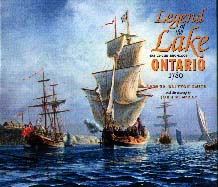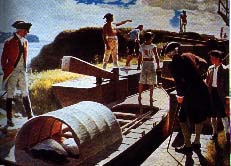


|
Legend of the Lake: The 22-Gun Brig-Sloop Ontario, 1780.
Arthur Britton Smith. Ships Drawing: John W. McKay, Paintings: Peter Rindisbacher.
Grades 10 and up / Ages 15 and up.
**** /4
|

excerpt:
The great hurricane of October 1780, the most devastating in a hundred years, had arisen 3,000 miles away in the Caribbean. On October 10th it sank a Royal Navy vessel the size of "Ontario" off the island of St. Lucia, the HMS Beaver's Prize formerly Oliver Cromwell. The same day HMS Cornwall [74 guns] and the HMS Vengeance [32] sank nearby, while at St. Vincent HMS Experiment [50] was lost.It was a very black month for the Royal Navy. As well, over one hundred merchant ships foundered or were driven ashore at great cost to Lloyd's of London, the insurers.
The hurricane continued northward, striking Bermuda on October 18th and taking a toll of a further fifty ships. Veering a little to the west, it crossed the New England coast and struck Lake Ontario a few days later. The north-east wind mentioned by Brigadier Powell would be the westerly part of the counter-clockwise hurricane, probably with winds upwards of 80 knots, which, after dark, would strike without warning.
 Death came swiftly Halloween night, 1780. Only six months after her christening, His Majesty's 22-Gun Brig Ontario foundered in the wake of the 18th century's most violent hurricane. Her resting place, the tomb of the 100 people who died in Lake Ontario's worst maritime disaster, was discovered by scuba divers in 1995.
Death came swiftly Halloween night, 1780. Only six months after her christening, His Majesty's 22-Gun Brig Ontario foundered in the wake of the 18th century's most violent hurricane. Her resting place, the tomb of the 100 people who died in Lake Ontario's worst maritime disaster, was discovered by scuba divers in 1995.
Ontario was built at the Carleton ship yards near Kingston, Ontario, to protect British Canada from invasion by American forces travelling up through the Great Lakes and river systems during the Revolutionary War. Because she was built in wartime, her short career was wrapped in secrecy. The British admiralty did not want the revolutionaries to know the brig's capabilities, and, after her loss, they did not want George Washington to know how weak the western defenses of Canada were. Arthur Smith believes that this shroud of secrecy still hides many truths about the Ontario.
A narrow study of the brig would be interesting to naval historians but hardly worthwhile for students and general readers. However, Smith has taken a more fertile structural approach by placing the detailed aspects of the ship's manufacture and military attributes within the framework of life on Lake Ontario during the later 18th century. The story of the Ontario becomes a rich history of the Great Lake lowlands' growing and hectic life.
Ships and ship building were vital for transportation, trade and security throughout the 18th and early 19th centuries. At the time Ontario was built, regiments of British solders were moving through the Lake Ontario region to meet the threat of Washington's armies. Loyalists were fleeing the revolutionary colonies and establishing new roots in the peninsula, and farmers, merchants and fur traders needed to move their goods and products.
The British Admiralty ship plans of Ontario show how complex it was to build a warship of 23 tons. The master shipwrights task was a daunting endeavour. These huge ships were actually very fragile and, in the harsh environment of the Great Lakes, had, at best, a very short lifetime. Ontario's captain, James Andrews, needed to be alert to the characteristics of his ship and to the changing elements lest tragedy befall his crew at any moment.
The text is complemented by 196 black/white and full colour illustrations. These include archival maps of the Lake Ontario region, paintings, lithographs, portraits from the 18th and 19th centuries, facsimiles of letters from merchants and soldiers, ship lists, museum pieces, and newspaper articles concerning Ontario's discovery. There are also full colour paintings and sketches of Ontario and her sister ships, Senaca, Hallimand and Limnade by Canadian artist Peter Rindisbacher.
Highly recommended.
Ian Stewart is a regular contributor to CM. He enjoys reading sea stories and drinking Jamaican dark rum with lime, the latter only to ward off the scurvy one can contract during Winnipeg's harsh winters.

To comment on this title or this review, send mail to cm@umanitoba.ca.
Copyright © 1998 the Manitoba Library Association. Reproduction for personal use is permitted only if this copyright notice is maintained. Any other reproduction is prohibited without permission.
Published by
The Manitoba Library Association
ISSN 1201-9364
TABLE OF CONTENTS FOR THIS ISSUE - JANUARY 2, 1998.
AUTHORS | TITLES | MEDIA REVIEWS | BOOKSHELF | BACK ISSUES | SEARCH | CMARCHIVE | HOME